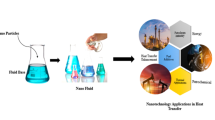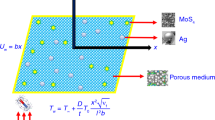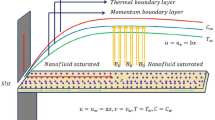Abstract
Regression analysis helps predict and understand the complex phenomena exhibited by fluids by examining the impact of independent variables on dependent variables. This article introduces a study that utilizes statistical analysis to explore the flow and heat transport behavior dynamics of a two-dimensional electrically conducting hybrid nanomaterial near the stagnation point. The innovation of this research lies in the novel synthesis method, which involves integrating molybdenum dioxide and aluminum oxide into a water-based fluid. The impacts of viscous dissipation, Joule heating (without an electric field), and convective boundary conditions are considered. This approach shows promise for practical applications across various industries. By comprehending and optimizing the behavior of hybrid nanofluids, potential benefits in the efficiency and performance of the system can be realized in areas such as electronics cooling and industrial heat exchangers. A significant aspect of this research involves the intelligent utilization of an external magnetic field oriented perpendicular to the flow direction. While this enhances energy flow, it also moderates the velocity profile of hybrid nanofluids. During regression analysis, it is observed that the effect of the Eckert number on the Nusselt number is greater than that of the Biot number.







Similar content being viewed by others
Abbreviations
- \(\left( {u,\,v} \right)\) :
-
Velocity components \({\text{m}}\,\,{\text{s}^{-1}}\)
- \(\left( {x,\,y} \right)\) :
-
Coordinates \(({\text{m}})\)
- \(U_0\),\(U_\infty\) :
-
Reference stretching and free stream velocities \(({\text{m}}/{\text{s}})\)
- \(T\) :
-
Temperature \(({\text{K}})\)
- \(T_w\) :
-
Surface/wall temperature \(({\text{K}})\)
- \(T_\infty\) :
-
Ambient temperature \(({\text{K}})\)
- \(U_\text{w} (x)\) :
-
Stretching velocity m s−1
- \(ne_1\) :
-
Free electron density e m−3
- \(e_1\) :
-
Electron charge \(({\text{C}})\)
- \(h_1\) :
-
Heat transfer coefficient \(({\text{W}}\,{\text{m}}^{-2} \,{\text{K}^{-1}})\)
- \(\tau_w\) :
-
Wall shear stress \(({\text{N}}\,{\text{m}}^{-2} )\)
- \(B_0\) :
-
Magnetic field strength \(({\text{A}}\,{\text{m}^{-1}})\)
- \(m^*\) :
-
Hall parameter \(({\text{m}}^3 \,{\text{C}^{-1}})\)
- \({\text{Re}}\) :
-
Reynolds number
- \(\Pr\) :
-
Prandtl number
- \(A\) :
-
Dimensionless velocity ratio
- \(\frac{\partial f(\xi ,\eta )}{{\partial \eta }}\) :
-
Non-dimensional velocity
- \(\theta (\xi ,\eta )\) :
-
Non-dimensional temperature
- \(M^*\) :
-
Magnetic parameter
- \(\gamma^*\) :
-
Biot number
- \(Ec^*\) :
-
Eckert number
- \(C_\text{f}\) :
-
Skin friction
- \({\text{Nu}}\) :
-
Nusselt number
- \({\text{MoS}}_2\) :
-
Molybdenum dioxide
- \({\text{Al}}_2 {\text{O}}_3\) :
-
Aluminum oxide
- \(\phi_\text{np1}\) :
-
\({\text{MoS}}_2\) Volume fraction
- \(\phi_\text{np2}\) :
-
\({\text{Al}}_2 {\text{O}}_3\) Volume fraction
- \(\mu_\text{hnf}\) :
-
Dynamic viscosity \(({\text{kg}}\,{\text{ms}^{-1}})\)
- \(\mu_\text{bf}\) :
-
Base fluid dynamic viscosity \(({\text{kg}}\,{\text{ms}^{-1}})\)
- \(\rho_\text{hnf}\) :
-
Density \(({\text{kg}}\,{\text{m}}^{-3} )\)
- \(\rho_\text{bf}\) :
-
Base fluid density \(({\text{kg}}\,{\text{m}}^{-3} )\)
- \(\alpha_\text{hnf}\) :
-
Thermal diffusivity \(({\text{m}}^2 \,{\text{s}^{-1}})\)
- \(\alpha_\text{bf}\) :
-
Base fluid thermal diffusivity \(({\text{m}}^2 \,{\text{s}^{-1}})\)
- \(\nu_\text{hnf}\) :
-
Kinematic viscosity \(({\text{m}}^2 \,{\text{s}^{-1}})\)
- \(\nu_\text{bf}\) :
-
Base fluid kinematic viscosity \(({\text{m}}^2 \,{\text{s}^{-1}})\)
- \(\sigma_\text{hnf}\) :
-
Electrical conductance \(({\text{S}}\,{\text{m}^{-1}})\)
- \(\sigma_\text{bf}\) :
-
Base fluid electrical conductivity \(({\text{S}}\,{\text{m}^{-1}})\)
- \(\kappa_\text{hnf}\) :
-
Thermal conductivity \((\text{W}\, \text{m}^{-1}\, \text{K}^{-1})\)
- \(k_\text{bf}\) :
-
Base fluid thermal conductivity \((\text{W}\, \text{m}^{-1}\, \text{K}^{-1})\)
- \(\kappa_\text{np1}\) :
-
\({\text{MoS}}_2\) Thermal conductivity \((\text{W}\, \text{m}^{-1}\, \text{K}^{-1})\)
- \(\kappa_\text{np2}\) :
-
\({\text{Al}}_2 {\text{O}}_3\) Thermal conductivity \((\text{W}\, \text{m}^{-1}\, \text{K}^{-1})\)
- \((c_\text{p} )_\text{hnf}\) :
-
Specific heat \(({\text{J}}\,{\text{kg}^{-1}}\, \text{K}^{-1})\)
- \((c_\text{p} )_\text{bf}\) :
-
Base fluid specific heat \(({\text{J}}\,{\text{kg}^{-1}}\, \text{K}^{-1})\)
- BVP:
-
Boundary value problem
- BCs:
-
Boundary conditions
- MHD:
-
Magnetohydrodynamic
- ODE:
-
Ordinary differential equation
- PDE:
-
Partial differential equation
References
Iijima S. Helical microtubules of graphitic carbon. Nature. 1991;354(6348):56–8.
Choi SU, Eastman JA. Enhancing thermal conductivity of fluids with nanoparticles. Developments and Applications of Non-Newtonian Flows, FED-vol. 231/MD-vol. 66, 1995;99–105.
Maxwell JC. On the dynamical theory of gases. Philos Trans R Soc Lond. 1867;157:49–88.
Sarkar J, Ghosh P, Adil A. A review on hybrid nanofluids: recent research, development and applications. Renew Sustain Energy Rev. 2015;43:164–77.
Akermi M, Jaballah N, Alarifi IM, Rahimi-Gorji M, Chaabane RB, Ouada HB, Majdoub M. Synthesis and characterization of a novel hydride polymer P-DSBT/ZnO nano-composite for optoelectronic applications. J Mol Liq. 2019;287:110963.
Babar H, Ali HM. Towards hybrid nanofluids: preparation, thermophysical properties, applications, and challenges. J Mol Liq. 2019;281:598–633.
Eid MR, Jamshed W, Abd-Elmonem A, Al-Hossainy AF, Almutlaq N, Amjad A, El Din SM. Energy bandgap and thermal characteristics of non-Darcian MHD rotating hybridity nanofluid thin film flow: Nanotechnology application. Nanotechnol Rev. 2023;12(1):20230159.
Ahmad S, Ali K, Rizwan M, Ashraf M. Heat and mass transfer attributes of copper–aluminum oxide hybrid nanoparticles flow through a porous medium. Case Stud Thermal Eng. 2021;25:100932.
Maraj EN, Zehra I, SherAkbar N. Rotatory flow of MHD (MoS2-SiO2)/H2O hybrid nanofluid in a vertical channel owing to velocity slip and thermal periodic conditions. Colloids Surf A. 2022;639:128383.
Khan AA, Arshad A, Ellahi R, Sait SM. Heat transmission in Darcy–Forchheimer flow of sutterby nanofluid containing gyrotactic microorganisms. Int J Numer Meth Heat Fluid Flow. 2023;33(1):135–52.
Muhammad K, Hayat T, Alsaedi A. Heat transfer analysis in slip flow of hybrid nanomaterial (Ethylene Glycol+ Ag+ CuO) via thermal radiation and Newtonian heating. Waves in Random and Complex Media, 2021;1–21.
Kumar B, Seth GS, Nandkeolyar R, Chamkha AJ. Outlining the impact of induced magnetic field and thermal radiation on magneto-convection flow of dissipative fluid. Int J Thermal Sci. 2019;146:106101.
Hayat T, Yazman M, Muhammad K, Momani S. Radiative and dissipative flow of hybrid nanofluid between two coaxial cylinders: a comparative numerical study. Alex Eng J. 2023;71:79–88.
Kumar B, Seth GS, Singh MK, Chamkha AJ. Carbon nanotubes (CNTs)-based flow between two spinning discs with porous medium, Cattaneo–Christov (non-Fourier) model and convective thermal condition. J Therm Anal Calorim. 2021;146:241–52.
Saha SC, Islam MS, Rahimi-Gorji M, Molla MM. Aerosol particle transport and deposition in a CT-scan based mouth-throat model. In: AIP conference proceedings, AIP Publishing, 2019;2121(1), 040011.
Khan LA, Raza M, Mir NA, Ellahi R. Effects of different shapes of nanoparticles on peristaltic flow of MHD nanofluids filled in an asymmetric channel: a novel mode for heat transfer enhancement. J Therm Anal Calorim. 2020;140:879–90.
Abd-Elmonem A, Kanwal S, Imtiaz M, Ali K, Ahmad S, Jamshed W, Eid MR, Abdalla NSE, ElSeabee FAA, El Din SM. Case study of heat generation/absorption and activation energy on MHD hybrid nanofluid (GO-MoS2/water) flow owing to a rotating disk. Case Stud Thermal Eng. 2023;51: 103632.
Sarfraz M, Khan M. Cattaneo-Christov double diffusion based heat transport analysis for nanofluid flows induced by a moving plate. Numer Heat Transf Part A: Appl. 2024;85(3):351–63.
Davidson PA, Belova EV. An introduction to magnetohydrodynamics. Am J Phys. 2002;70:781–781.
Sheikholeslami M, Ganji DD, Javed MY, Ellahi R. Effect of thermal radiation on magnetohydrodynamics nanofluid flow and heat transfer by means of two phase model. J Magn Magn Mater. 2015;374:36–43.
Ghalambaz M, Sabour M, Sazgara S, Pop I, Trâmbiţaş R. Insight into the dynamics of ferrohydrodynamic (FHD) and magnetohydrodynamic (MHD) nanofluids inside a hexagonal cavity in the presence of a non-uniform magnetic field. J Magn Magn Mater. 2020;497:166024.
Kumar B, Singhal A, Nandkeolyar R, Kumar P, Chamkha AJ. Regression analysis and features of negative activation energy for MHD nanofluid flow model: a comparative study. Propuls Power Res. (2023).
Raghunath K. Study of heat and mass transfer of an unsteady magnetohydrodynamic (MHD) nanofluid flow past a vertical porous plate in the presence of chemical reaction, radiation and soret effects. J Nanofluids. 2023;12(3):767–76.
Ali I, Saleem MT. Applications of orthogonal polynomials in simulations of mass transfer diffusion equation arising in food engineering. Symmetry. 2023;15(2):527.
Biswas N, Mandal DK, Manna NK, Benim AC. Enhanced energy and mass transport dynamics in a thermo-magneto-bioconvective porous system containing oxytactic bacteria and nanoparticles: cleaner energy application. Energy. 2023;263:125775.
Zeeshan A, Ahmad M, Ellahi R, Sait SM, Shehzad N. Hydromagnetic flow of two immiscible nanofluids under the combined effects of Ohmic and viscous dissipation between two parallel moving plates. J Magn Magn Mater. 2023;575:170741.
Adesanya SO, Onanaye AS, Adeyemi OG, Rahimi-Gorji M, Alarifi IM. Evaluation of heat irreversibility in couple stress falling liquid films along heated inclined substrate. J Clean Prod. 2019;239:117608.
Hayat, T., Muhammad, K. and Momani, S. Melting heat and viscous dissipation in flow of hybrid nanomaterial: a numerical study via finite difference method. J Thermal Anal Calorim. (2022) 1–9.
Kumbhakar B, Nandi and Chamkha AJ. Unsteady hybrid nanofluid flow over a convectively heated cylinder with inclined magnetic field and viscous dissipation: a multiple regression analysis. Chin J Phys 2002;79:38–56.
Kumawat C, Sharma BK, Al-Mdallal QM, Rahimi-Gorji M. Entropy generation for MHD two phase blood flow through a curved permeable artery having variable viscosity with heat and mass transfer. Int Commun Heat Mass Transf. 2022;133:105954.
Sarfraz M, Khan M, Al-Zubaidi A, Saleem S. Tribology-informed analysis of convective energy transfer in ternary hybrid nanofluids on inclined porous surfaces. Tribol Int. (2023) 108860.
Muhammad K, Fatima N, Abdelmohsen SA, Alyousef HA. Mixed convective magnetohydrodynamic flow of hybrid fluid with viscous dissipation: a numerical approach. J Magn Magn Mater. 2023;573:170667.
Ouada M, Kezzar M, Talbi N, Eid MR, Sari MR, Yousef WM, Elsaid EM. Heat transfer characteristics of moving longitudinal porous fin wetted with ternary (Cu–Al2O3–TiO2) hybrid nanofluid: ADM solution. Eur Phys J Plus. 2023;138(9):1–12.
Ellahi R, Zeeshan A, Waheed A, Shehzad N, Sait SM. Natural convection nanofluid flow with heat transfer analysis of carbon nanotubes–water nanofluid inside a vertical truncated wavy cone. Math Methods Appl Sci. 2023;46(10):11303–21.
Shamshuddin MD, Saeed A, Mishra SR, Katta R, Eid MR. Homotopic simulation of MHD bioconvective flow of water-based hybrid nanofluid over a thermal convective exponential stretching surface. Int J Numer Meth Heat Fluid Flow. 2024;34(1):31–53.
Acknowledgements
The authors would like to acknowledge Deanship of Graduate Studies and Scientific Research, Taif University for funding this work.
Author information
Authors and Affiliations
Corresponding author
Additional information
Publisher's Note
Springer Nature remains neutral with regard to jurisdictional claims in published maps and institutional affiliations.
Rights and permissions
Springer Nature or its licensor (e.g. a society or other partner) holds exclusive rights to this article under a publishing agreement with the author(s) or other rightsholder(s); author self-archiving of the accepted manuscript version of this article is solely governed by the terms of such publishing agreement and applicable law.
About this article
Cite this article
Muhammad, K., Nisar, Z., Alhuthali, A.M.S. et al. Statistical and numerical analysis of electrically conducting hybrid nanomaterial near the stagnation region. J Therm Anal Calorim (2024). https://doi.org/10.1007/s10973-024-13095-7
Received:
Accepted:
Published:
DOI: https://doi.org/10.1007/s10973-024-13095-7




